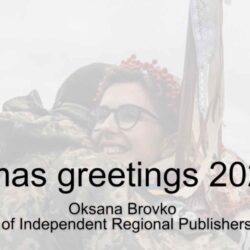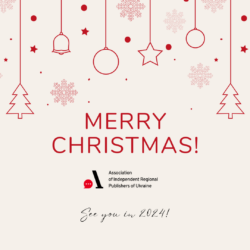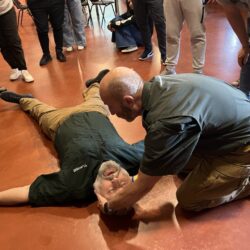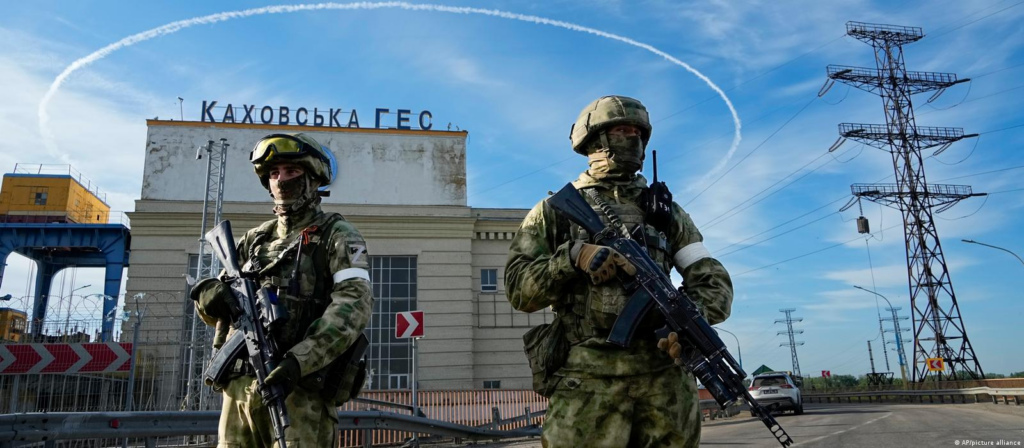
Yevhen Veselov
The russian invaders began to threaten to blow up the Kakhovka HPP dam last spring, but this threat reached its peak in October. The so-called evacuation, and actually the deportation of the civilian population from the right bank of the Dnipro to the left one, was allegedly due to the claim by the russians that Ukraine was going to blow up the dam.
The condition of the Kakhovka HPP facilities and the consequences of flooding in the event of the dam’s destruction are still at the top of the rating among propagandists. Of course, they accuse Ukraine of preparing a probable disaster, but it is known that the invaders partially mined the Kakhovka HPP facilities. Based on the fact that russia is a terrorist state, it is impossible to ignore the threat. In addition, the hydraulic facility is still under russian control, and the Ukrainian army has plans to liberate the entire Kherson Oblast and Crimea.
WHY DOES THE THREAT STILL EXIST?
The successful operations of the Ukrainian Armed Forces in the Kherson area only aggravate the issue of security for the local residents both in the liberated territory of the right bank and in the temporarily occupied territory of the left bank. This is because, since the first days of the full-scale invasion, russian troops have been in full control of the Kakhovka HPP and the facilities of the North Crimean Main Canal.
The Kakhovka HPP and the head office of the North Crimean Canal are located in the neighbouring towns of Nova Kakhovka and Tavriisk, approximately 70 to 80 kilometres from Kherson, which the Ukrainian Armed Forces liberated on November 11. The russians captured these strategic sites in the morning of February 24, when they launched an offensive from occupied Crimea.
The Security Service of Ukraine identified two servicemen of the russian federation who gave criminal orders to occupy the Kakhovka HPP and blow up the North Crimean Canal facilities. These are the deputy commander of the Black Sea Fleet of the russian federation for logistics, Major General Mikhail Yasnikov, and the commander of the 11th separate engineering brigade, Colonel Dmitry Markov.
All this time, the russians have controlled the Kakhovka HPP and the North Crimean Canal as strategic objects. The dam and the bridge across it are a logistical supply chain for the russian army, and the water that went through the canal to Crimea is an economic component because, for the first time since 2014, the occupied peninsula has received water.
As long as the russians control these strategic facilities, there will be a threat. But even if they leave the HPP, in theory, they will still be able to control the explosives they filled the hydraulic structures with remotely.
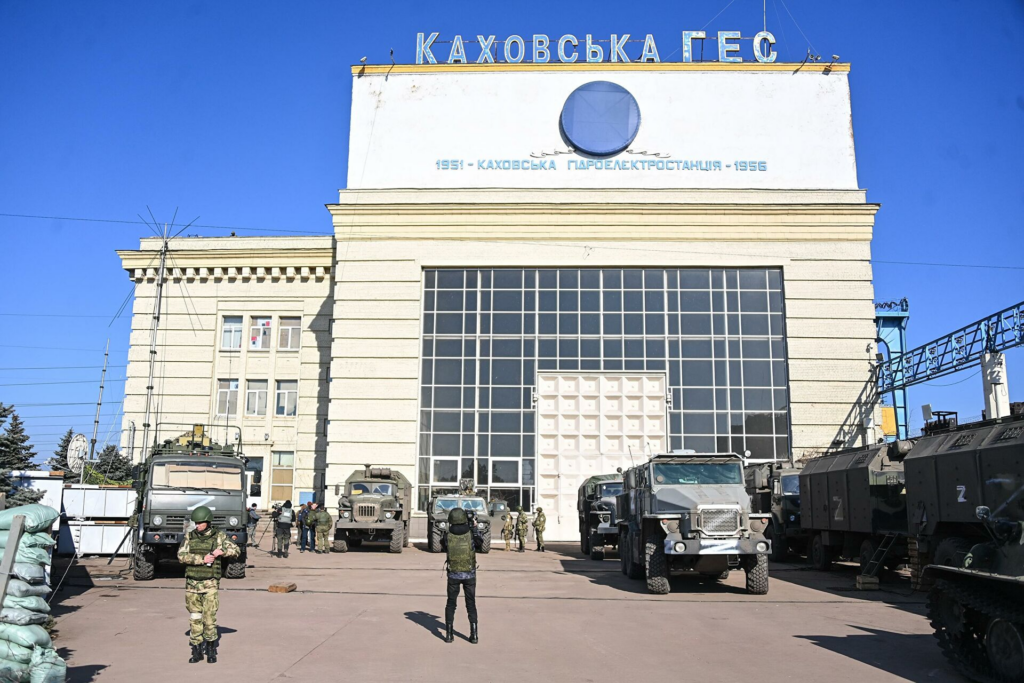
We are trying to figure out how real this threat is and what the consequences might be.
But we must note that it was not September or October, when the russians began to sow panic around the Kakhovka HPP. A lot has happened since then. First, the russians have left the right bank of the Dnipro, and secondly, the whole world already knows about putin’s terrorist nature. This is already reflected in political decisions. Among them is the adoption on November 23 of a resolution recognizing russia as a state sponsor of terrorism by the European Parliament. The symbolic resolution was approved by 494 votes, 58 deputies were against it, and 44 abstained, reports Euronews.
The members of the European Parliament condemned russia’s illegal, unprovoked, and unjustified war of aggression. They accused the russian army of committing a long list of crimes: attacks on infrastructure facilities, killings of civilians, including children, mass executions, kidnappings, rapes, oppression, torture, numerous detentions, and forced deportations. Lawmakers also condemned russia for provoking a large-scale humanitarian crisis and using food and starvation as a weapon.
The European Parliament calls on the EU member states to develop a new legal framework that will allow declaring an entire country a sponsor of terrorism. It should be reminded that the parliaments of Lithuania, Latvia, Estonia, the Czech Republic, and Poland recognized russia and its regime as terroristic.
On October 13, the PACE adopted a resolution in support of Ukraine. In the document, the russian regime is recognized as a terrorist.
On November 21, the NATO Parliamentary Assembly recognized the russian federation as a terrorist state and called for creating a special court to punish russian criminals, “Slovo i Dilo” reports. Adviser to the head of the Office of the President of Ukraine Mykhailo Podoliak commented on the consequences of such decisions for russia: “The status of a terrorist country will affect the reputation of the russian federation because russia will not be able to be a sponsor and a partner of many events and thus will lose a key element of influence on foreign elites.”
So, the civilized world considers russia a rogue and criminal country. And how did russia react to the resolution of the European Parliament? On November 23, it again fired almost 70 rockets at the critical infrastructure of Ukraine, at residential buildings. Fortunately, most of them were shot down by Ukrainian Air Defence, but it took several days for the state to recover from the effects of the attack. Also, from the left bank russia continues to shell Kherson, which was liberated from the invaders on November 11, and the entire right bank. Although the russians have left the regional centre, putin’s propaganda continues to tell its population that Kherson is a “russian city” from which the Nazis, that is, the Ukrainian Army, will soon be expelled. Therefore, we have no right to relax.
LET’S DEFINE THE TERMINOLOGY
When talking about the Kakhovka HPP, experts often confuse concepts and sometimes misinterpret certain events. As a result, rumours are born, and panic is created, which the enemies always use to their advantage. For example, even the President, in his address, calls the dyke a dam. And one of the military experts confused the shelling of the bridge over the dam with the shelling of the dam itself.
So, we suggest defining the terminology. Citations further in the material will be presented in the original language.
The Kakhovka Reservoir is one of six large reservoirs in the cascade on the Dnipro River in the Zaporizhia, Dnipropetrovsk, and Kherson Oblasts. It was created by the dam of the Kakhovka HPP (near the town of Nova Kakhovka).
A dam is a hydro-technical structure that retains water and creates a difference in water levels.
A dyke is a hydraulic structure in the form of an embankment to protect the territory from floods, surround man-made reservoirs and watercourses, and direct the flow of water in the desired direction. Therefore, it is more correct to talk about the dam in relation to the Kakhovka HPP.
A bridge over a dam is a bridge structure that rests on a dam. Damage to the bridge does not cause damage to the dam.
Sluice – the Kakhovka single-chamber, single-thread shipping sluice is used for vessels to overcome the concentrated level difference in the cross-section of the Kakhovka HPP dam. The sluice consists of upper and lower heads and a sluice chamber. The length of the navigable chamber is 260 m; its width is 18 m. The design number of sluice operations per day is 32. The pressure on the structure is 16 m. The upper head of the sluice is equipped with flat working and emergency repair gates; the lower one is equipped with double-leaf working and repair gates.
The North Crimean Canal is an irrigation facility, irrigation and watering canal in the south of Ukraine (Kherson Oblast and the Autonomous Republic of Crimea). It takes water from the Kakhovka Reservoir. Until 2014, the canal provided almost 85% of Crimea’s fresh water supply. Crimea has not received water since April 2014.
On 24 February 2022, the russian invaders occupied the Kakhovka HPP and, accordingly, the beginning of the canal. The facilities of the canal in the town of Tavriisk were also seized. The dyke built near Kalanchak, which blocked the water supply to Crimea, was broken, and the water went again to Crimea.
CHRONOLOGY OF EVENTS
On 24 February 2022, the russian invaders seized the facilities of the North Crimean Canal and the Kakhovka HPP. The technical staff was allowed to work.
From February 24 to 28, on the orders of Yasnikov and Markov, the russians blew up the sluices and dams on the 78th and 91st kilometres of the North Crimean Canal, and also damaged the sector gates on the 107th kilometre. After that, the water from the Kakhovka Reservoir flowed to occupied Crimea.
In April, Western experts reported on the probable mining of the Kakhovka HPP dam. In May, the HPP began discharging large volumes of water. Nova Kakhovka (the embankment and park) was partly flooded.
On July 29, the Ukrainian military launched a high-precision missile attack on the road bridge leading to the HPP through the sluice. The railway track was disabled.
On August 10 and 12, the Ukrainian military again launched a rocket attack on the road bridge, which was significantly damaged.
In September, four out of six units of the HPP were functioning. That is, the station was operating at 2/3 of its installed capacity and was part of the energy system of Ukraine.
On October 18, the Gauleiter of the Kherson Oblast, Volodymyr Saldo, announced the evacuation of residents from the right bank of the Dnipro to the left bank, to occupied Crimea and russia.
On October 20, President of Ukraine Volodymyr Zelenskyi stated that “russian terrorists mined the dyke and units of the Kakhovka Hydroelectric Plant. If they blow up this dam, more than 80 communities, including Kherson, would be in the zone of rapid flooding.”
On November 1, the russians began evacuating the civilian population from the 15-kilometer zone of the left bank of the Dnipro, allegedly due to threats related to the detonation of the Kakhovka HPP dam by the Ukrainian troops and the flooding of the territories.
On November 11, during the withdrawal of russian troops to the left bank of the Dnipro, the invaders spread information that the sluices of the Kakhovka HPP were blown up. But this was not true. The road surface on the right bank side was destroyed. Although there is a risk of flooding downstream, it is insignificant.
On November 15, the Gauleiter of the Kherson Oblast, Volodymyr Saldo, announced that the Kakhovka HPP no longer produced electricity and was disconnected from the unified energy system of Ukraine.
As of November 23, the Kakhovka HPP and North Crimean Main Canal facilities are under the control of the invaders.

WHAT IS KNOWN ABOUT THE MINING OF THE KAKHOVKA HPP FACILITIES
In an interview to “Ukrainska Pravda” the head of the Main Directorate of Intelligence (MDI) of the Ministry of Defence of Ukraine, Kyrylo Budanov, commented on the information about the mining of the dam as follows:
“The dyke is partially mined, that’s true. Well, it is very difficult to evaluate the stupidity of russians using any logic. I will say this: blowing up this dyke will definitely cause an environmental disaster; that’s a fact. There are just other aspects. First: why do it – what will they lose, and what will they gain? And the second: you can partially blow up the dam, or you can blow it up completely. So, in order to blow it up completely, such works have not been carried out. Mining has been carried out partially for partial destruction, if necessary. To destroy a structure of this level, tens of tons of explosives correctly planted are needed. You can’t put KamAZ somewhere nearby; it won’t do anything,” said the head of the MDI.
According to Budanov, even if the russian invaders dare to take such a step, launch all the missiles they have, and plant a lot of explosives, they will lose more than they will gain as a result of blowing up the dyke in the Kherson Oblast.
“They will provoke the large-scale flooding of the left bank of the Kherson Oblast. They will lose, even in theory, the possibility of supplying water to the North Crimean Canal, to Crimea, until we rebuild the dyke, and that will take a very long time. It will be impossible to do.
And the most interesting thing is that they will terminate the Zaporizhia NPP’s existence because this facility is inextricably linked to it. Well, of course, they will make it difficult for us to advance for a certain period of time.
But they will be forced to retreat directly to Crimea. In other words, if they cause complete destruction, then the scenario will be as mentioned above. Are they ready for it? I think they aren’t,” Budanov stressed.
If the invaders decide to partially destroy the Kakhovka HPP dyke, the water spill, according to the head of the Ukrainian Intelligence Service, will be partial, but not so terrible.
“They will disable the sluice section and engine rooms. That is, they will make the dyke unsuitable for its intended use. But the North Crimean Canal will be preserved and there will be a partial spill of water, but it will not be so terrible. So I don’t think they intend total destruction. In addition, we do not see any signs of the full mining of this structure,” he emphasized.
It is clear that such comments by Budanov clarify the situation at least somewhat, but for Olena, a resident of Kozachi Laheri from the left-bank Kherson Oblast, they mean little. She has to make a decision for herself whether to save the children and leave the village, which, in the event of a disaster, will be in the flood zone, or to calm down. And such questions are asked by many families.
There can be only one piece of advice here: to calm down and not panic. Even if the worst scenario comes true, it will be possible to leave the flooded area within a short time period: it will be necessary to move away from the river for only a few tens of kilometres. One can also move towards Crimea. The invaders still offer this option, but it is a one-way ticket because in reality the residents of the Kherson Oblast are being deported to russia without being given the opportunity to return. So it is not known which threat is more terrible. But every mother and every family will eventually make their decision, which will be right for them.
POSSIBLE CONSEQUENCES OF THE KAKHOVKA HPP DAM DESTRUCTION
In his address to the European Council on October 20, President of Ukraine Volodymyr Zelenskyi outlined the main possible consequences of the Kakhovka HPP dam destruction.
“If the russian terrorists blow up this dyke, more than 80 communities, including Kherson, will be in the zone of rapid flooding,” he emphasized.
The President also listed other consequences of blowing up the Kakhovka HPP and its dyke:
– hundreds of thousands of residents in the south of Ukraine will be in the danger zone and may suffer from the triggered flood;
– the water supply of a large part of southern Ukraine and Crimea may be destroyed. The North Crimean Canal will simply disappear in the event of the Kakhovka HPP dam destruction;
– a russian terrorist attack may leave the Zaporizhia Nuclear Power Plant without water for cooling because the water for the ZNPP is taken from the Kakhovka Reservoir;
– general destructive environmental, humanitarian, and man-made consequences of such a terrorist attack will reach the scale of a historical disaster.
In a situation where the enemy is hitting critical infrastructure, the possible blowing-up is a continuation of russia’s tactics to destroy our economy.
“This HPP is essential in the energy complex. Considering the volume of water, the potential of the aggregates concentrated there… The enemy knows this, wants to destroy, it and, in this way, harm our economy,” explains the director of the Institute of Water Problems and Land Development of the National Academy of Sciences of Ukraine, Mykhailo Yatsiuk.
THE RESIDENTIAL AREA OF NOVA KAKHOVKA WILL NOT BE DAMAGED
The head of the Novo Kakhovka Society for the Protection of Cultural Landmarks, Tetiana Yevseeva, describes the potential consequences for Nova Kakhovka.
“When the hydroelectric power plant is blown up, the water level in Nova Kakhovka will reach up to Dniprovskyi Avenue,” says the architect. – Marking of the water level in the Kakhovka Reservoir is +14 m. Marking of Dniprovskyi Avenue is from 15 m and higher. The park and its buildings will be damaged. The residential area will not. When the town was designed, the possibility of such a disaster was taken into account, so it was decided to develop the avenue only on one side, although buildings in the project were designed closer to the Dnipro.”
Here is a fragment of the general plan of the town, which is available on the official website of the Nova Kakhovka Town Council. The blue dotted line is the line of possible flooding due to an accident at the HPP.

According to Tetiana Yevseeva, the maximum water level in the reservoir can be +16 m. The level of flooding ranges from +14 m to +12 m in the area of the Workers’ Settlement – the western suburb of Nova Kakhovka – and further on, about 5 km from the HPP. Kherson is almost 60 km away. The wave must pass along the left bank.
The flooding will start from Korsunka, says the head of the Kakhovka Society for the Protection of Cultural Landmarks. “The villages of Osnova and Dnipriany will not be affected as they have a high bank,” continues Tetiyana Yevseeva. – The flooding will start from Korsunka, and the water will spill over the lowlands, all the way to Nova Maiachka. In Kherson, the water level will hardly rise to the urban buildings of the right bank, but the left bank will be heavily flooded.”
After the publicity received from the potential blowing-up of the dam, the russians began to drain water from the Kakhovka Reservoir massively. But these actions can also lead to problems. If the water level drops to 14 meters, it will be critical for the operation of the ZNPP because it is the cooling level of the units.
WILL RUSSIA DARE TO LOSE CONTROL OF THE KAKHOVKA HPP?
Until early November, the popular opinion among Ukrainian and foreign military analysts and experts was that russia would not dare to deprive Crimea of its water supply, and all the threats and informational attacks surrounding the flooding due to the blowing-up of the dam were only to distract the public and evacuate its military to the left bank. This is exactly what the invaders did: they spread rumours about the dam mining, sowed panic, announced the evacuation of civilians, and began to withdraw their troops under its cover.
But now, when the russians were driven from the right bank, they continued to evacuate civilians from the left bank deep into the region. They built several lines of defence, the first of which is exactly in the 15-kilometer zone of the left bank. From there, they are randomly shelling Kherson and the entire right bank. There is an assumption that if the invaders are forced to leave the HPP and concentrate on protecting the left bank, they may blow up the dam and, therefore, complicate the advance of the Ukrainian troops and the liberation of the left bank. The worse, the better – this logic fits perfectly into the actions of this terrorist country.
Arguments against this scenario include the threat of losing the source of water for Crimea forever. But on the other hand, it is the inevitability of losing the peninsula, which was defiantly annexed in 2014, that may prompt the invaders to commit a terrorist attack.
In any case, the threat exists because, as mentioned above, the actions of the terrorist country cannot be logically explained.
WHAT MUST THE RESIDENTS OF THE KHERSON URBAN COMMUNITY DO IN THE EVENT OF A BREACH OF THE KAKHOVKA HPP DAM
The flooding will begin in 2 hours!!!
“The water level in the Dnipro River may rise to 5 m after the breach. The maximum water level will be reached in 13 hours and 48 minutes. The flood peak will last for 3 hours 30 minutes,” says the Civil Defence Department of the city of Kherson.
Step-by-step instructions
1. Turn off electrical appliances and gas stoves; take documents, necessary things, food, and drinking water.
2. Residents living along the coastline of the Dnipro and Koshova rivers should move to the following safe areas:
– residents of the Antonivka township go up to Gorky and Antonivska Streets;
– residents of the Dnipro District go up to Khersonska Street (in the area of Viacheslav Chornovil Square), Viacheslav Chornovil Highway, and Perekopska Street;
– residents of the Suvorovsky District go up to Gimnazychna, Soborna, and Gretska Streets;
– residents of the Korabelny District, including the Quarantine Island, go up to Kachelna Street (above Korabeliv Square) and Poltavska Street;
– residents of the Quarantine Island, if they cannot evacuate to a safe area, should go up to the level of the third floor of buildings;
– residents of the village of Zymivnyk go up to the area of the city cemetery;
– residents of Komyshany go up to Tsentralna Street; and
– residents of Priozerne go above Bilozerska Street.
3. Provide assistance to sick people and the elderly. Notify your neighbours of the danger.
WHAT MUST THE RESIDENTS OF THE LEFT BANK OF THE DNIPRO DO?
Volodymyr Molchanov, an expert at the Black Sea Centre for Political and Social Studies, told Suspilne that the probable blowing-up of part of the HPP facilities would cause no global catastrophe. In his opinion, the blowing-up will lead to the flooding of the left bank of the Dnipro. Events can unfold according to the following scenario.
“The dyke is 4 meters below the bridge crossing. If the upper sluice gate is destroyed, then a sixteen-meter high tsunami through the 20-meter channel will move directly to this dyke and wash it away. The water level will decrease because the Dnipro is wider than the sluice channel. The wave will be approximately 2.5 meters high and it will hit the bank of Nova Kakhovka in the area of electric poles, where they go to the substation. There is no housing there. Just green areas,” said Molchanov.
According to the expert, neither people nor their property will be harmed because they are not physically there. Then the wave height will continue decreasing.
“On the left bank, most likely, water will flood the basements of the houses of Nova Kakhovka, Dnipriany, Kozachi Lageri, Krynkiv, Pishchany, Oleshky, as well as summer cottages near the Antonivsky bridge,” says Volodymyr Molchanov.
Based on the map of possible flooding, the residents of the left bank should go to the territory located approximately 20 km away from the Dnipro and its extensive system of tributaries. Therefore, people should move in the direction of Crimea.
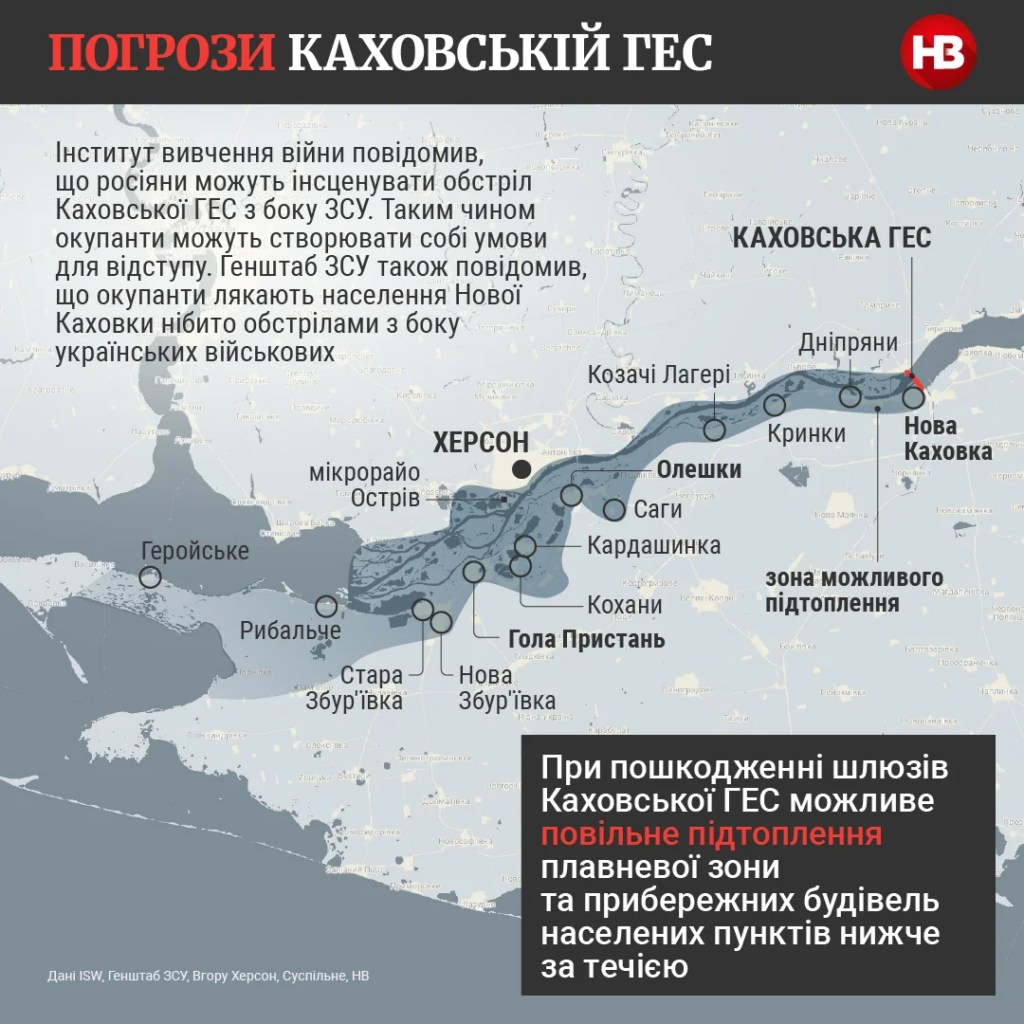
| Каховська ГЕС | Kakhovka HPP |
| Мікрорайон Острів | Ostriv micro district |
| ХЕРСОН | KHERSON |
| Саги | Sahy |
| Козачі Лагері | Kozachi Laheri |
| Дніпряни | Dnipriany |
| Олешки | Oleshky |
| Кринки | Krynky |
| Нова Каховка | Nova Kakhovka |
| Геройське | Heroiske |
| Кардашинка | Kardashynka |
| Кохани | Kokhany |
| Зона можливого підтоплення | Zone of possible flooding |
| Гола Пристань | Hola Prystan |
| Рибальче | Rybalche |
| Стара Збур’ївка | Stara Zburiivka |
| Нова Збур’ївка | Nova Zburiivka |
The situation on the left bank is complicated by the fact that all the communities are currently under russian control; Ukrainian mobile communication services are unavailable there. So, if the invaders decide to commit a terrorist attack, they can begin withdrawing troops from the 20-kilometer zone from the Dnipro. But russians can also flee because of the offensive operations of the Ukrainian Armed Forces. Therefore, residents must always be ready for any developments – from liberation to evacuation. But the main thing is to hold on and be aware that even if the dam is blown up, everyone will have time to save themselves by moving to a safe distance out of the potential flooding zone. There can be no tsunami or instant flooding in principle.
EMERGENCY SUITCASE FOR FAMILIES WITH CHILDREN
Who knows what can be expected from an insidious enemy who is meanly shelling the right bank of the Dnipro from the left bank. Scenarios of the development of events may vary. And this concerns not only events that may develop around the Kakhovka HPP. So just in case, we remind you of the need to pack an emergency suitcase. It is especially important to have it if there are children nearby.
Suggested content of the emergency suitcase:
– a package with documents (birth certificate, passport, medical card);
– a note from the parents stating the child’s last name, first name, patronymic, date of birth, place of residence, contacts of parents and other relatives and friends, blood group and allergens, doctors’ phone numbers and other important information at your discretion;
– family photo (optional);
– a first-aid kit with approved medicines;
– snacks and water;
– preferably a whistle or other signalling devices;
– charged phone, power bank, and charger;
– flashlight;
– changing clothes and underwear; and
– a small favourite toy – It will calm the child in a stressful situation.
If you have very small children or babies with you, you should additionally take:
– diapers;
– a pacifier;
– changing clothes and underwear for babies;
– dry infant formula or puree that babies can drink;
– dishes where this food can be steamed;
– necessary children’s medicines (in addition to the basic package for adults);
– children’s dry and wet wipes.
We suggest using a bright tourist backpack as an emergency suitcase. You should not take a suitcase or a bag, as it will be inconvenient to carry them for a long time. The priority room in the bag should be provided for documents, money, medicine, means of communication, means for heating, food, and a minimum set of clothes. You can put less necessary things on the bottom, and medicine, documents, water, and snacks on top.
Regarding documents. They should be placed in a waterproof bag or a file fastened with a stapler. The originals should be kept close to the body – in a sweatshirt under a jacket or inner pockets because they will be needed when registering on evacuation lists, etc. Also, they cannot be lost or thrown away if you have to get rid of your backpack for some reason.
Food should be taken for several days. These can be:
– canned goods (for example, ready-made side dishes);
– black chocolate;
– chocolate bars;
– dried meat (for example, cabanos packaged thin dried sausages);
– galettes, cookies;
– lozenges;
– nuts, dried fruits;
– mivina (puree or noodles); and
– sticks with instant coffee and/or tea bags.
Make sure to take water. Preferably for 1-2 days in a bottle or in special bags for liquids. Each person should be given at least 1-1.5 litters of water.
As for clothing, experts recommend wearing several layers of clothing to avoid overloading your bag. It should be taken into account that you will have to spend a significant part of the time either outside or in cold rooms, so dress so that you will not get cold during the day: a warm sweater, a hat, gloves, and a scarf. Shoes should be comfortable, warm, and sporty.
You should put in your suitcase:
– warm socks (2+ pairs per person);
– underwear (2+ pairs);
– a changeable t-shirt or fleece jacket; and
– raincoat.
And medicines are the most important items. A separate first-aid kit must be prepared for children from the following medicines:
– antipyretic;
– antihistamines (antiallergic) medicines;
– hemostatic medicines;
– antidiarrheal medicines;
– plasters;
– sterile napkins;
– antiseptics;
– painkillers;
– medicines for intestinal infections;
– throat sprays;
– drops for the nose;
– anti-inflammatory eye drops; and
– medicines that you take on a regular basis.
We emphasize that this is an approximate list of the items to be carried in an emergency suitcase, specifically for children, which we made using several sources. These are, in particular, the recommendations of the Ministry of Education and Science of Ukraine.
For adults, the content of the suitcase is somewhat different because it includes a different list of documents, medicines, hygiene products, personal belongings, means of heating, recommendations for keeping money and other important things.
We believe in the Armed Forces of Ukraine! Let’s hold on!
Prepared under the auspices of the Association “Independent Regional Publishers of Ukraine” as part of the implementation of the grant project “The Women in News with WAN-IFRA”. The views of the authors do not necessarily reflect the official position of the partners.
